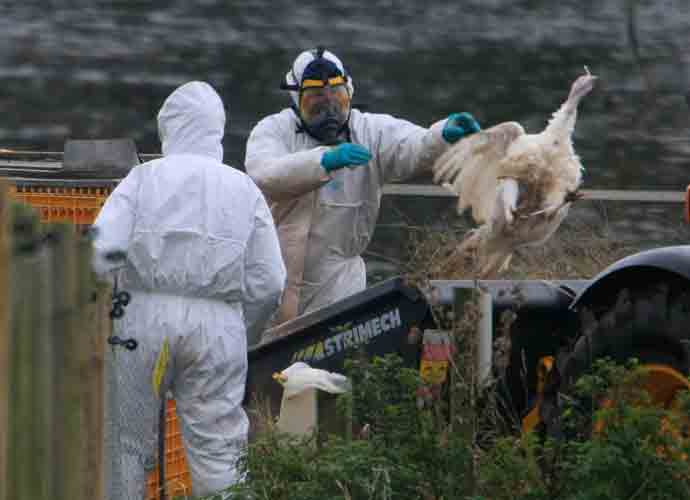

DISS, UNITED KINGDOM - NOVEMBER 13: DEFRA (Department for Environment, Food and Rural Affairs) workers clear up dead turkey carcasses at Redgrave Park Farm where around 2,600 birds, including ducks and geese, are being slaughtered following the confirmed outbreak of the H5 strain of bird flu, on November 13, 2007 in Redgrave, Suffolk, near Diss, Norfolk, England. A 3km protection zone and a 10km surveillance zone has been established around the infected premises. Following further tests, DEFRA has announced at a press conference that this particular virus does contain the highly infectious H5N1 substrain of Aviation Influenza (the fourth outbreak H5N1 in the UK this year), which in rare cases can spread to other species, including humans. (Photo by Jamie McDonald/Getty Images)
Despite years of warnings about the health risks associated with consuming raw milk, sales of unpasteurized products appear to rise, even after a bird flu outbreak among dairy cows.
Market research firm NielsenIQ reported a 21% to 65% increase in weekly raw cow’s milk sales since March 25, when the bird flu virus was confirmed in U.S. cattle for the first time.
This surge in sales happens despite the advice provided by the Food and Drug Administration (FDA) and the Centers for Disease Control and Prevention (CDC). Both of these agencies have labeled raw milk as one of the “riskiest” foods to consume. The CDC warns that raw milk can be contaminated with harmful germs that can cause serious illness.
As of Monday, federal officials have identified at least 42 herds in nine states with cows infected by the H5N1 strain of the bird flu virus. The virus has been found in high levels in the raw milk of infected cows and has raised concerns about potential transmission to humans.
The possibility of live virus transmission through raw milk consumption remains unknown. However, CDC officials have cautioned that individuals who drink raw milk could become infected if the bird flu virus comes into contact with receptors in the nose, mouth, throat or lungs through inhalation. There is also concern that increased exposure to the virus could lead to mutations that facilitate its spread among people.
Regulations regarding raw milk vary widely among states. Some allow retail sales in stores, others permit sales only at farms, and some allow cow-sharing arrangements where individuals pay for milk from designated animals. NielsenIQ’s sales figures encompass grocery stores and other retail outlets and reveal that raw milk products constitute a small fraction of overall dairy sales.
Nevertheless, testimonials that endorse raw milk have gained traction on social media platforms. The CDC says that raw milk accounted for over 200 illness outbreaks between 1998 and 2018, which has affected more than 2,600 people and resulted in over 225 hospitalizations. Research indicates that raw milk is more likely than pasteurized milk to cause illnesses and hospitalizations related to dangerous bacteria such as campylobacter, listeria, salmonella and E. coli. Before the adoption of milk standards in 1924, approximately 25% of foodborne illnesses in the U.S. were linked to dairy consumption. Today, dairy products account for only about 1% of such diseases.
This growing preference for raw milk reflects a broader issue of government mistrust and the rejection of expertise, as highlighted by Matthew Motta, a researcher of health misinformation at Boston University.
In a pointed Instagram post on Friday, Phang addressed the cancellation and drew attention to…
John Cena confessed to undergoing hair replacement surgery only a day after his record-breaking 17th…
Speaking about the challenges of the filming environment, Lambe laughed, “I mean, what was easy…
An insider reported, “She was really, really sick and open with those in her circle…
Other celebrities to criticize the trip to space include Emily Ratajowski, Olivia Munn and even…
Biggerstaff went on to share more posts in support of the transgender community, writing, “Today…